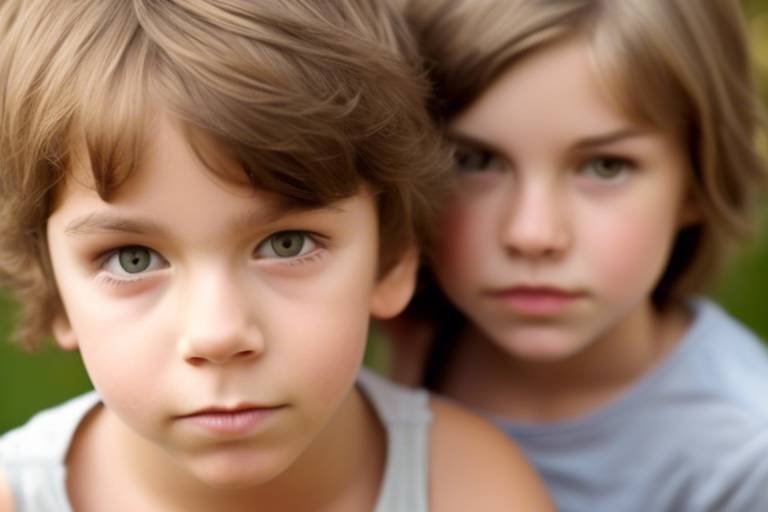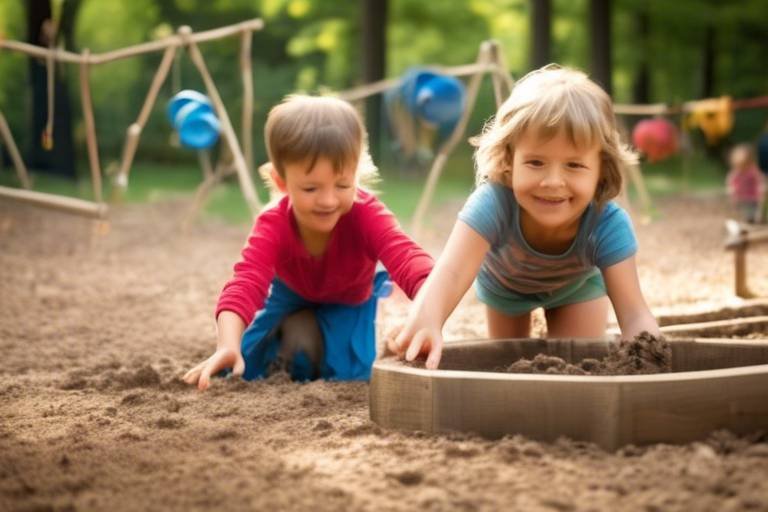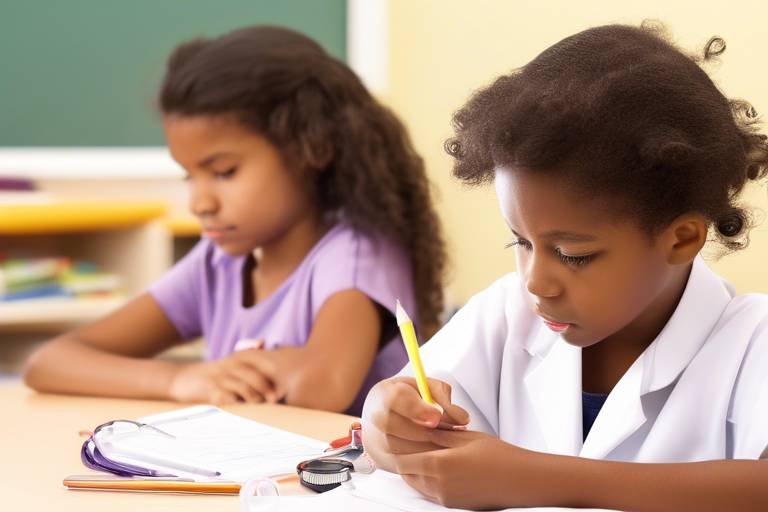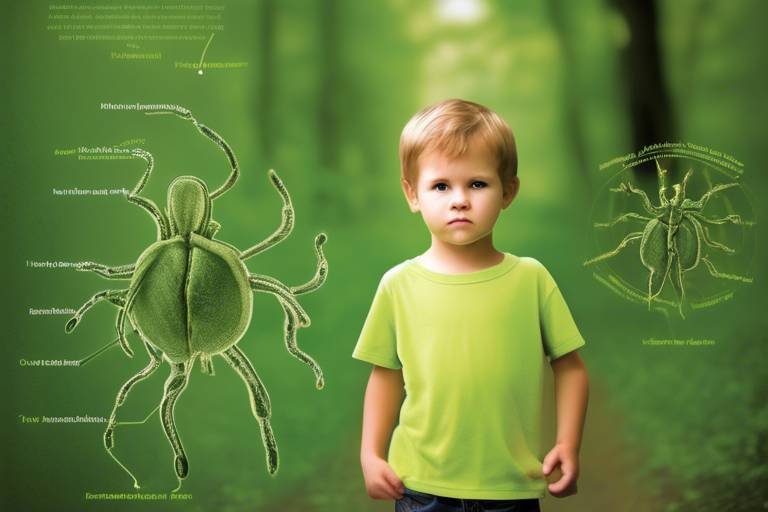Depression in Kids and Teens: Spotting the Signs
In today's fast-paced world, the mental health of our children and teenagers is more important than ever. Depression in young individuals is a growing concern, often overlooked or misinterpreted. Recognizing the signs early can be a game-changer, leading to timely intervention and support. Imagine your child as a vibrant flower; if it starts to wilt, wouldn't you want to know why? This article explores the signs of depression in children and adolescents, highlighting the importance of early detection and intervention for better mental health outcomes.
Understanding depression in youth requires a closer look at its unique characteristics. Unlike adults, children and teens may not express their feelings as openly or may not even recognize their own emotional struggles. Symptoms can vary widely, ranging from emotional distress to physical complaints. The causes of depression in this age group can be complex, often stemming from a combination of genetic, environmental, and psychological factors. It's essential to note that while adults may exhibit more pronounced signs of depression, young individuals often show subtler symptoms that can easily be missed.
As parents or caregivers, being aware of the common signs of depression can make a significant difference. It’s not just about noticing sadness; it’s about understanding the broader spectrum of symptoms that may indicate something deeper. Here are some key indicators to look for:
Emotional symptoms are often the first red flags when it comes to identifying depression in kids and teens. These can include:
- Persistent Sadness: A child who seems down or tearful most of the time may be struggling.
- Irritability: Increased irritability or mood swings can often mask underlying sadness.
- Feelings of Hopelessness: Expressions of feeling worthless or hopeless should never be taken lightly.
Frequent sadness and unexplained crying spells can signify deeper emotional struggles. If a child who was once joyful suddenly seems to be crying more often, it’s essential to take notice. These emotional outbursts may not just be typical mood swings; they could indicate a need for support and understanding from caregivers and mental health professionals.
A noticeable decline in interest in activities once enjoyed is another clear sign of depression. Think of it like a favorite toy that has lost its charm; if your child used to love playing soccer or painting and suddenly shows no interest, it’s crucial to explore the reasons behind this change.
Physical symptoms of depression can manifest in various ways, and recognizing them is essential. Changes in sleep patterns, such as insomnia or oversleeping, can be significant indicators. Similarly, fluctuations in appetite—either eating too much or too little—are common. Energy levels may also dip, leaving a child feeling fatigued and lethargic. These physical signs are just as important as emotional ones, as they can impact a child's overall well-being.
The effects of depression can significantly disrupt a child's daily life. It can seep into every aspect, including academic performance, social interactions, and family relationships. This makes it vital to address these issues promptly. When a child is struggling with depression, it can create a ripple effect, impacting not only their own life but also the lives of those around them.
Depression can lead to difficulties in concentration, resulting in declining grades and a lack of motivation to engage in schoolwork. Imagine a once enthusiastic student now staring blankly at their homework, feeling overwhelmed and unable to focus. This decline can be alarming for parents and teachers alike, as it often signifies that the child is battling more than just academic pressure.
Social withdrawal is a common behavior in depressed teens, leading to isolation and further exacerbating feelings of loneliness and despair. When a once-social child starts to pull away from friends and family, it’s a sign that something might be wrong. They may prefer to stay home rather than participate in activities they once loved, creating a cycle of loneliness that can be hard to break.
Q: What should I do if I suspect my child is depressed?
A: The first step is to talk to your child openly and compassionately. Encourage them to express their feelings and consider seeking help from a mental health professional.
Q: Are there any specific risk factors for depression in children?
A: Yes, factors such as family history of depression, trauma, and significant life changes can increase the risk of depression in children and teens.
Q: Can depression in kids be treated effectively?
A: Absolutely! With the right support, therapy, and sometimes medication, many children and teens can manage their depression successfully.

Understanding Depression in Youth
Depression in children and adolescents is a complex and often misunderstood condition that goes beyond mere sadness. It's essential to recognize that youth depression can manifest in various ways, making it crucial for parents, educators, and caregivers to understand its unique characteristics. Unlike adults, who may express their struggles with clearer verbal communication, young individuals often exhibit their feelings through behavior, making it vital to pay close attention to changes in their demeanor.
One of the most significant aspects of depression in youth is its symptomatology. Symptoms can range widely, but they generally include emotional and physical signs. For instance, while adults might articulate feelings of sadness or despair, children and teens may show their distress through irritability, anger, or withdrawal from previously enjoyed activities. This can lead to confusion for parents and guardians, who may not immediately recognize these behaviors as indicators of depression.
Furthermore, the causes of depression in youth can be as varied as the symptoms themselves. Factors such as genetics, environmental influences, and life experiences all contribute to a young person's mental health. Stressful life events, such as family changes, bullying, or academic pressure, can trigger depressive episodes. It's important to note that depression is not simply a phase; it is a serious condition that requires attention and intervention.
Another crucial point to consider is how youth depression differs from adult depression. For example, while adults may experience prolonged periods of low mood, children and teens might oscillate between emotional highs and lows, making it harder to diagnose. Additionally, the stigma surrounding mental health can prevent young people from seeking help, leading to a cycle of silence and suffering.
In summary, understanding depression in youth involves recognizing the unique symptoms, varied causes, and distinctive expressions of this condition. By fostering an environment of open dialogue and support, we can help our children navigate their emotional landscapes more effectively, ensuring they receive the help they need when they need it most.

Common Signs of Depression
Recognizing the signs of depression in children and teens is crucial for early intervention and support. Many parents and caregivers may find it challenging to identify these signs, as they can often be subtle or mistaken for typical adolescent behavior. However, being aware of the common symptoms can make a significant difference in a young person's life. Let's dive into some of the key indicators that may suggest a child or teen is struggling with depression.
Emotional symptoms are often the most telling signs of depression. Children and teens may exhibit persistent feelings of sadness, irritability, and hopelessness that linger longer than usual. It's essential to observe any sudden changes in mood or behavior, as these can be red flags. For instance, if a once cheerful child suddenly becomes withdrawn and moody, it might be time to investigate further. Some common emotional symptoms include:
- Sadness and Crying Spells: Frequent sadness and unexplained crying can signify deeper emotional struggles. If your child seems to cry often without a clear reason, it’s important to provide a supportive environment where they feel comfortable expressing their feelings.
- Loss of Interest: A noticeable decline in interest in activities that were once enjoyable is another clear sign of depression. Whether it's sports, hobbies, or socializing with friends, a lack of enthusiasm can indicate that something deeper is going on.
Depression doesn't just affect emotions; it can also manifest in physical symptoms. Children and teens may experience changes in sleep patterns, appetite, and energy levels. For example, a child who used to have a healthy appetite may suddenly lose interest in food, or a teen who was once active may become lethargic and fatigued. Here are some physical symptoms to look out for:
- Changes in Sleep Patterns: Insomnia or oversleeping can both be indicators of depression. If your child is consistently having trouble falling asleep or sleeping excessively, it could be a sign of emotional distress.
- Appetite Changes: Significant weight loss or gain can also be concerning. If your child is eating much less or more than usual without explanation, it’s worth investigating.
- Low Energy Levels: A general lack of energy can affect a child’s ability to engage in daily activities, making them seem sluggish or disinterested.
It's vital to approach these signs with empathy and understanding. If you notice these symptoms persisting, consider reaching out to a mental health professional who can provide support and guidance. Early detection and intervention can significantly improve outcomes for children and teens experiencing depression.
Q1: What should I do if I suspect my child is depressed?
A1: Start by having an open and honest conversation with your child. Express your concerns and encourage them to share their feelings. If the symptoms persist, consider seeking help from a mental health professional.
Q2: Are there specific age groups more prone to depression?
A2: While depression can affect anyone, it often emerges during adolescence. However, younger children can also experience depression, so it's essential to be vigilant at any age.
Q3: Can depression in children be treated effectively?
A3: Yes, depression in children can be treated effectively through therapy, medication, or a combination of both. Early intervention is key to improving outcomes.

Emotional Symptoms
When it comes to spotting depression in kids and teens, emotional symptoms are often the most telling signs. It's crucial for parents and caregivers to be vigilant and attentive, as these symptoms can sometimes be subtle yet profoundly impactful. One of the primary indicators is persistent sadness. If a child seems to be in a constant state of gloom, it could be more than just a passing phase. This sadness may not always manifest as tears; instead, it can appear as a general lack of enthusiasm for life. Think of it like a cloudy day that just won't clear up—no matter how much the sun tries to shine through.
Another emotional symptom to watch for is irritability. You might notice your child snapping at friends or family over trivial matters, or perhaps they seem easily frustrated. This irritability can be a mask for deeper feelings of sadness or hopelessness. It’s important to remember that this isn’t just typical teenage angst; it can be a significant warning sign that something is amiss.
Feelings of hopelessness are also critical emotional indicators. If your child expresses thoughts like "nothing will ever get better" or "I can't do anything right," these statements should raise red flags. Such feelings can create a vicious cycle, where the child becomes more withdrawn and less likely to seek help. It’s as if they’re trapped in a dark tunnel with no light at the end, making it essential for caregivers to provide support and guidance.
Additionally, frequent crying spells can be a clear indicator that a child is struggling emotionally. These outbursts may seem disproportionate to the situation at hand, which can be confusing for parents. But remember, these tears are often a release of pent-up emotions that need to be addressed. Just as a pressure cooker needs to be vented to prevent an explosion, children must find healthy ways to express their feelings.
Lastly, a noticeable loss of interest in activities that once brought joy is a significant sign of emotional distress. If your child used to love playing soccer or painting but now seems indifferent, it’s time to take notice. This shift can indicate that depression is stealing their joy, much like a thief in the night. Encouraging open conversations about their feelings can help them feel less isolated and more understood.
In summary, being aware of these emotional symptoms is vital for early detection of depression in children and teens. By recognizing signs like persistent sadness, irritability, hopelessness, crying spells, and loss of interest, parents can take proactive steps to support their child. Remember, it’s not just about noticing these signs; it’s about taking action to ensure that your child feels seen, heard, and loved during their most challenging times.
- What should I do if I suspect my child is depressed?
It's essential to approach the situation with empathy. Start by having an open conversation with your child, letting them know they can share their feelings without judgment. If necessary, consider seeking help from a mental health professional. - Are emotional symptoms of depression different in kids compared to adults?
Yes, children and teens may express emotional symptoms differently than adults. While adults may verbalize their feelings of sadness, children might exhibit irritability or withdrawal instead. - How can I support my child if they are showing signs of depression?
Offer a listening ear, encourage them to talk about their feelings, and engage in activities together that they once enjoyed. Professional help, such as therapy, can also be beneficial.

Sadness and Crying Spells
When it comes to children and teens, persistent sadness and crying spells can often be the tip of the iceberg in terms of emotional struggles. Imagine a vibrant, joyful child suddenly turning into a shadow of their former self—this transformation can be alarming for parents and caregivers. It's essential to recognize that these emotional indicators are not just fleeting moments; they can signal deeper issues that require attention and understanding.
Children and adolescents may not always have the words to express what they’re feeling, leading to frustration and confusion. Instead of articulating their distress, they may resort to tears or a sullen demeanor. This behavior can sometimes be misinterpreted as mere moodiness or a phase they’ll grow out of. However, it’s crucial to differentiate between typical emotional fluctuations and signs of depression. When you notice a child who seems to be sad most of the time or frequently bursts into tears over minor issues, it’s a red flag that shouldn’t be ignored.
Moreover, crying spells can occur unexpectedly. A child might be engaged in a seemingly normal activity, like playing a game or watching a movie, when suddenly they are overwhelmed by sadness. This unpredictability can leave both the child and their caregivers feeling helpless. It's important to create a safe environment where the child feels comfortable expressing their emotions. Encouraging open conversations about feelings can help them feel less isolated and more understood.
Here are some signs to watch for that may accompany sadness and crying spells:
- Increased irritability: A child who is normally cheerful may become easily frustrated or angry.
- Changes in sleep patterns: Look for signs of insomnia or excessive sleeping, which can accompany emotional distress.
- Withdrawal from activities: If a child who once loved sports or hobbies suddenly loses interest, it’s worth investigating further.
It’s essential to approach these signs with compassion and patience. Rather than jumping to conclusions, take the time to talk to your child. Ask open-ended questions that encourage them to share their feelings. For example, instead of asking, “Why are you sad?” try, “Can you tell me what’s been on your mind lately?” This shift can open up a dialogue that allows them to express themselves more freely.
In conclusion, sadness and crying spells in children and teens are more than just typical mood swings; they can be significant indicators of underlying depression. By recognizing these signs early and fostering an environment of support and understanding, caregivers can help guide their loved ones toward the help they may need. Remember, acknowledging their feelings is the first step in providing the necessary support to navigate through these challenging emotions.
- What should I do if I notice my child is frequently sad or crying? - It's important to talk to your child about their feelings and consider seeking professional help if the sadness persists.
- How can I support my child during this time? - Listen to them without judgment, encourage them to express their feelings, and consider involving a mental health professional if necessary.
- Are there any resources available for parents? - Yes, various organizations offer support and resources for parents dealing with children's mental health issues. Websites like the National Alliance on Mental Illness (NAMI) can be a great starting point.

Loss of Interest
One of the most telling signs of depression in children and teens is a noticeable decline in interest in activities they once enjoyed. Imagine a bright, colorful world suddenly fading to gray; this is often how young individuals experience their passions slipping away. When your child, who used to eagerly anticipate playing soccer or painting, suddenly shows no enthusiasm for these activities, it can be a significant red flag. This shift is not just a phase; it often indicates that something deeper is troubling them.
As parents and caregivers, it’s crucial to recognize these changes early on. The loss of interest can manifest in various ways, such as:
- Disinterest in Hobbies: Activities like playing video games, drawing, or reading may no longer hold the same appeal.
- Avoidance of Social Activities: Your teen might start avoiding friends or family gatherings, preferring to stay home alone.
- Declining Participation in Sports: If your child was once passionate about a sport, their sudden reluctance to practice or play can be concerning.
It's essential to approach this situation with empathy and understanding. Instead of dismissing their lack of interest as mere teenage angst, try to engage in open conversations. Ask them how they feel about their hobbies and if there’s anything bothering them. This dialogue can help them feel supported and understood, making it easier for them to express their feelings.
In many cases, the loss of interest can lead to a cycle of isolation and despair. As they withdraw from activities, they may also withdraw from social interactions, which can exacerbate feelings of loneliness. It’s akin to a snowball effect; the more they pull away, the heavier the emotional burden becomes. Therefore, it's vital to address these changes promptly and seek professional help if necessary. Early intervention can make a world of difference in a young person's life.
Ultimately, recognizing the loss of interest is just the first step. The next involves taking action—whether that’s encouraging them to re-engage with their passions, seeking counseling, or simply being there to listen. Remember, your support can be a lifeline for them during these challenging times.
- What should I do if I notice my child losing interest in activities?
Start by having an open conversation with them about their feelings. Encourage them to express themselves and consider seeking professional help if the behavior persists.
- How can I support my child through their loss of interest?
Be patient and understanding. Offer to participate in activities with them or introduce new hobbies that might reignite their interest.
- When should I seek help from a mental health professional?
If your child’s loss of interest lasts for an extended period or is accompanied by other concerning symptoms such as changes in sleep or appetite, it may be time to consult a professional.

Physical Symptoms
When we think about depression, we often focus on the emotional aspects, but it's equally important to recognize the that can accompany this mental health condition, especially in children and teens. These symptoms can manifest in various ways and can sometimes be the first indicators that something is amiss. For instance, a child who once bounced out of bed every morning may suddenly struggle to get up, leading to a noticeable change in their routine. This shift can be alarming for parents and guardians, as it might indicate that the child is experiencing deeper emotional turmoil.
One of the most common physical symptoms of depression is changes in sleep patterns. Some kids may sleep excessively, using sleep as a way to escape their feelings, while others may suffer from insomnia, tossing and turning as their minds race with worries. This lack of restful sleep can lead to a cascade of other issues, such as fatigue and irritability, further complicating their emotional state. In fact, a study has shown that over 60% of children with depression experience sleep disturbances, highlighting the importance of addressing these issues promptly.
Another critical physical symptom to watch for is changes in appetite. This can manifest as either a significant increase or decrease in food intake. A child who once enjoyed family meals may suddenly lose interest in food altogether, or they might start eating excessively as a coping mechanism. This change can lead to noticeable weight loss or gain, which can be concerning not just for their physical health but also for their self-esteem. Parents should be vigilant and consider keeping a record of their child's eating habits to spot any worrying trends.
Additionally, you might notice a drop in energy levels. Children and teens who are depressed often feel fatigued and lethargic, even after a full night's sleep. They might complain about feeling physically drained or exhibit a lack of motivation to engage in daily activities. This fatigue can affect their ability to participate in sports or hobbies they once loved, leading to further isolation and despair. Recognizing these physical symptoms is crucial, as they often serve as the tipping point that prompts parents to seek help.
To sum it up, the physical symptoms of depression in kids and teens can be diverse and sometimes subtle. Here’s a quick overview of some key symptoms to keep an eye on:
- Changes in sleep patterns (insomnia or oversleeping)
- Altered appetite (eating less or more than usual)
- Fatigue and lack of energy
- Physical complaints (headaches, stomachaches, etc.)
Recognizing these signs early can lead to timely intervention, which is essential for helping young individuals navigate their mental health challenges. If you notice any of these symptoms persisting over time, it’s important to consult with a healthcare professional who specializes in adolescent mental health.
Q: What should I do if I suspect my child is depressed?
A: If you suspect your child is experiencing depression, the first step is to talk to them openly and supportively. Encourage them to express their feelings. It may also be beneficial to consult a mental health professional who can provide a proper assessment and recommend treatment options.
Q: How can I support my child through their depression?
A: Providing a supportive environment is crucial. Listen to them without judgment, validate their feelings, and encourage them to engage in activities they enjoy. Professional help, such as therapy, can also be a significant part of their recovery.
Q: Are physical symptoms of depression different for boys and girls?
A: While both boys and girls can experience similar physical symptoms, boys may exhibit more externalizing behaviors such as aggression, while girls may internalize their feelings, leading to more pronounced physical symptoms like fatigue and changes in appetite.

Impact on Daily Life
Depression in children and adolescents isn't just a fleeting phase; it can have a profound impact on their daily life. Imagine a vibrant child who once lit up the room with laughter, now sitting quietly in a corner, lost in thought. The effects of depression can ripple through various aspects of their existence, leaving parents and caregivers feeling helpless and confused. It's crucial to recognize that the emotional turmoil can lead to significant disruptions in their academic performance, social interactions, and family relationships.
When we talk about academic challenges, it's essential to understand that depression often clouds a child's ability to concentrate. Have you ever tried to focus on a task while a storm rages outside? That’s what it feels like for a child battling depression. They may find it increasingly difficult to keep up with schoolwork, leading to a decline in grades and a lack of motivation. The once enthusiastic student may start to feel overwhelmed by assignments, resulting in missed deadlines and incomplete homework. This cycle can be discouraging, as poor academic performance can further exacerbate feelings of inadequacy and hopelessness.
Equally concerning is the issue of social withdrawal. Imagine being at a party, surrounded by friends, yet feeling utterly alone. This is often the reality for depressed teens. They may begin to retreat from social activities, avoiding interactions with peers and family members. This isolation can create a vicious cycle: the more they withdraw, the more they feel lonely, which can deepen their depression. Friends may notice their absence and stop reaching out, further isolating the child. It's heartbreaking to see a once-social butterfly transform into a wallflower, but this is a common symptom that needs attention.
Moreover, the impact of depression extends beyond academics and social life; it can also strain family relationships. Parents might feel frustrated or helpless, unsure of how to support their child. Communication can break down, leading to misunderstandings and conflict. Family dynamics can shift as siblings may feel neglected or confused about the changes in their brother or sister. This can create an environment filled with tension, making it even harder for the child to seek help or express their feelings. It’s like a ripple effect; one person’s struggle can affect the entire family unit.
In summary, recognizing the impact of depression on daily life is vital for early intervention and support. By addressing academic challenges, promoting social engagement, and fostering healthy family communication, caregivers can help children navigate through their struggles. It’s essential to create an environment where they feel safe to express their feelings and seek help. Remember, spotting the signs early can make a significant difference, transforming despair into hope.
- What are the signs of depression in children?
Signs include persistent sadness, irritability, withdrawal from activities, changes in appetite, and difficulty concentrating. - How can I help my child if I suspect they are depressed?
Open communication is key. Encourage them to talk about their feelings and seek professional help if necessary. - Is it normal for teens to feel sad sometimes?
Yes, it is normal for teens to experience sadness, but persistent feelings of hopelessness may indicate depression. - When should I seek professional help for my child?
If your child's symptoms persist for more than two weeks or interfere with daily life, it's time to consult a mental health professional.

Academic Challenges
When depression creeps into the lives of children and teens, it often manifests in academic challenges that can be both alarming and frustrating. Imagine a bright, curious child who once thrived in school suddenly struggling to keep up with assignments or losing interest in subjects they once loved. This shift can be a clear indicator that something deeper is going on. Depression can cloud a young person's mind, making it difficult to focus, retain information, or even muster the motivation to attend classes.
One of the most significant impacts of depression on academic performance is the inability to concentrate. Kids who are dealing with emotional turmoil might find their minds wandering during lessons, leading to missed information and poor understanding of the material. This can create a vicious cycle: as grades slip, feelings of inadequacy and hopelessness can deepen, further exacerbating the depression. It's like trying to run a race while carrying a heavy backpack—no matter how hard they try, the weight of their emotions can hold them back.
Moreover, the lack of motivation that often accompanies depression can lead to procrastination and incomplete assignments. Students may find themselves staring at a textbook for hours without absorbing a single word, feeling overwhelmed by the pressure to perform. It’s crucial for parents and educators to recognize these signs early on. Not only can early intervention help mitigate the academic fallout, but it can also provide the necessary support for the child to regain their footing.
In some cases, schools may offer resources like counseling services, which can be incredibly beneficial. These services provide a safe space for students to express their feelings and develop coping strategies. Additionally, teachers can play a pivotal role by being vigilant and understanding. They can offer accommodations, such as extended deadlines or modified assignments, to help students cope with their struggles without feeling further burdened.
Ultimately, addressing academic challenges related to depression requires a collaborative effort between parents, teachers, and mental health professionals. By working together, they can create an environment that fosters healing and growth, allowing children and teens to not only recover academically but also emotionally. Remember, the goal is not just to improve grades but to nurture a child's overall well-being and help them rediscover their love for learning.
- What are the first signs of depression in children? Look for persistent sadness, irritability, and a noticeable loss of interest in activities they once enjoyed.
- How can parents help a child who is struggling with depression? Open communication is key. Encourage them to talk about their feelings and consider seeking professional help if needed.
- Are there specific academic accommodations for depressed students? Yes, schools can offer extended deadlines, modified assignments, and access to counseling services to support these students.

Social Withdrawal
Social withdrawal is often one of the most telling signs of depression in children and teens. Imagine a vibrant garden suddenly losing its flowers; that's what happens when a young person who once thrived in social settings begins to retreat into their shell. This behavior can manifest in various ways, from skipping social events to a complete disinterest in friendships. It's crucial for parents and caregivers to recognize these changes, as they can lead to a cycle of isolation that only deepens feelings of loneliness and despair.
When a child or teen withdraws socially, it often stems from feelings of inadequacy or fear of judgment. They might feel like they don’t fit in or believe that others won’t understand their struggles. This can lead to a self-imposed exile from activities they once enjoyed, such as sports, clubs, or even just hanging out with friends. As they pull away, they miss out on the very connections that could help them heal, creating a vicious cycle that feeds their depression.
It's not just about the absence of social interaction; the emotional toll can be immense. The longer a child withdraws, the more they may feel disconnected from their peers, leading to an increase in negative thoughts and feelings. This isolation can also affect family dynamics, as parents and siblings may feel helpless or frustrated by their loved one's unwillingness to engage. It’s essential to approach this situation with empathy and understanding, rather than frustration or anger.
To help combat social withdrawal, consider the following strategies:
- Encourage Open Communication: Create a safe space for your child to express their feelings without judgment.
- Reintroduce Social Activities Gradually: Start with small gatherings or one-on-one interactions to ease them back into social environments.
- Seek Professional Help: Sometimes, talking to a therapist can provide the tools needed to navigate these feelings and rebuild connections.
Recognizing and addressing social withdrawal early is key. The sooner parents and caregivers can intervene, the better the chances for a positive outcome. Remember, it’s not just about getting them back into social situations; it’s about nurturing their mental health and helping them feel valued and understood. Every step taken towards re-engagement is a step away from the shadows of depression.
- What are the first signs of depression in children? Look for changes in mood, behavior, and interest in activities they once enjoyed.
- How can I help my child who is socially withdrawn? Encourage open dialogue, gradually reintroduce social activities, and consider professional support.
- When should I seek professional help for my child's depression? If you notice persistent symptoms or significant changes in behavior, it's time to consult a mental health professional.
Frequently Asked Questions
- What are the common signs of depression in children and teens?
Common signs include persistent sadness, irritability, changes in sleep patterns, loss of interest in activities, and physical symptoms like fatigue. It's crucial for parents and caregivers to be vigilant and recognize these indicators early.
- How does depression in kids differ from adult depression?
While the core symptoms may be similar, children and teens often express their feelings differently. They might show more irritability or anger rather than sadness. Additionally, their coping mechanisms and understanding of emotions are still developing, making it essential to approach their mental health with care and understanding.
- What should I do if I suspect my child is depressed?
If you suspect your child is experiencing depression, the first step is to talk to them openly and non-judgmentally. Encourage them to express their feelings and seek professional help if necessary. A mental health professional can provide a proper assessment and recommend appropriate interventions.
- Can depression in kids lead to academic challenges?
Absolutely! Depression can significantly affect a child's ability to concentrate, leading to declining grades and a lack of motivation. It's essential to address these challenges early to support their academic performance and overall well-being.
- How can I support my child if they are diagnosed with depression?
Supporting a child with depression involves listening to them without judgment, encouraging open communication, and being patient. It’s also important to foster a supportive environment and consider involving mental health professionals for therapy or counseling.
- Is it normal for teens to withdraw from social activities?
While some withdrawal can be typical during adolescence, a significant and prolonged withdrawal from social activities can be a warning sign of depression. If you notice this behavior, it's essential to check in with your teen and offer support.
- What role do parents play in preventing depression in children?
Parents play a crucial role by fostering open communication, being attentive to their child's emotional needs, and creating a stable and supportive home environment. Encouraging healthy habits like regular exercise and good sleep can also help in prevention.
- Are there effective treatments for childhood depression?
Yes, depression in children can be treated effectively through a combination of therapy, medication, and lifestyle changes. Cognitive-behavioral therapy (CBT) is particularly effective, and medication may be prescribed in more severe cases. It’s vital to work closely with a healthcare provider to find the best approach.



















